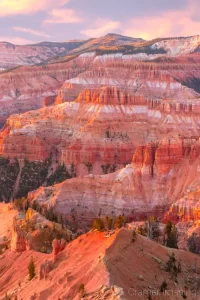
Fall leaves have a narrow window of time. They appear and fade withing a matter of weeks to a month. Higher elevations show off their colors much sooner than lower elevations do. So, when the autumn colors started peeping, I naturally pulled out my camera and sought out 1 of my local higher elevation haunts. Autumn color descended upon Cedar Breaks National Monument and I didn’t want to miss a moment of it.

During my research, I ended up realizing that this trip was also a great night to try for some astro-landscape photography as well. The moon was below the horizon and the Milky Way would be visible. I could photograph the autumn leaves of Cedar Breaks at sunset, wait a bit, then capture the Milky Way over the cliffs. So, I prepared for both options. It seemed prudent for me to do so. Opportunity favors the prepared, after all.
Cedar Breaks offers lots of evergreen forest. Deciduous forest is a bit far between up there. Still, there are places where you can find such fall color. The road up there offers several such opportunities. Also, I found just such a view there where a crown of autumn color sits atop the bright red-orange cliffs of the Cedar Breaks amphitheater. All you need is to seek out these autumn colors earlier in the season and you have it all.
Upon arriving, we realized that we also timed things perfectly to join in a star party. Cedar Breaks National Monument, as a dark sky park, has some amazing dark skies. The rangers love to feature them. They offer solar viewings and star parties to the tourists. We happened into 1 such party and decided to take advantage of it.
Once sunset was over, I set up my camera for the rise of the Milky Way in the southern skies. Then I joined in the star party. While I waited for my camera to take the series of Milky Way photos I wanted, I took advantage of the rangers’ telescopes to observe some deep sky objects. These objects included the Andromeda galaxy, the Whirlpool galaxy, the Hercules cluster, and more.
As I went back and forth between the telescopes, I also checked in with my camera. I captured this scene of the Milky Way galactic core over Cedar Breaks.
I couldn’t help but try out a monochrome version of the same scene. Don Riddle is right when he says that black and white versions are much closer to what our eyes see in the field.
So, reader, what do you think of these autumn and astro-landscape photos of Cedar Breaks National Monument? What do you think of all the timing involved? Did I get lucky like I think I did? Please share your thoughts in the comments section below.
Join our email-only photo of the week club to get the full stories behind how we captured our favorite fine art landscape photos.
We respect your privacy.


Receive monthly updates in your inbox from us.

Join our email-only photo of the week club to get the full stories behind how we captured our favorite fine art landscape photos.
We respect your privacy
No More Results